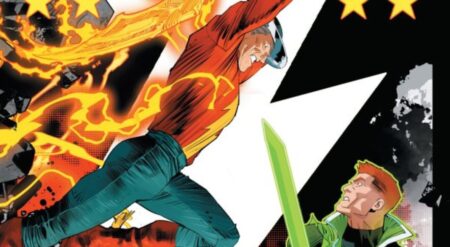Green Arrow #18 is published by DC Comics. Written by Chris Condon, art by Montos, colors by Adriano Lucas and letters by Hassan Otsmane-Elhaou. Green Arrow returns to protecting Star City just as someone starts murdering billionaires.
This issue returns to basics. Starting alone, Green Arrow returns to fighting crime in the dark alleyways of Star City. There is a brilliant simplicity to the concept and purity to the storytelling. Condon’s first issue is slow, tapping into the heart of what Oliver Queen and Green Arrow stand against.
A billionaire has been murdered as revenge for a misdeed that hasn’t been revealed yet. The structure changes slightly, dipping into flashbacks to show Queen’s history with the deceased. This raises the mystery that shrouds the rest of the book in secrecy. The last section of Green Arrow #18 becomes a detective story. It ends with a scrappy fight that introduces an interesting new character at the same time.
The new creative team shuffles the cast dramatically. This first chapter shrinks Team Arrow to just one: Oliver Queen. This makes sense for multiple reasons. It’s a terrific jumping point, allowing the new readers to enjoy Green Arrow on his own. It also fits the narrative of where Joshua Williamson ended his run. Oliver betrayed the team, leading to friction and fractions within the group. This is not to say that the rest of the team will appear later in the series, but the decision will allow the book to grow naturally.
Green Arrow #18 can be quiet when it needs to be. Ollie gives small comments or groans of pain when investigating or watching TV, but Condon is comfortable letting the art do the talking. However, the book also sometimes erupts into noise. The flashback shows an argument featuring a slightly younger Queen. It is here that Condon displays his direct and distinct dialogue. The new character freshens up the series’ mythos, giving Ollie someone to bounce off who doesn’t know him well at all.
The art plunges Green Arrow back into the shadows. This is a gloomy, dark issue. The shadows are thick, and the silhouettes are solid on the streets and in the city. This makes Green Arrow’s surroundings dangerous and uncertain, with anyone capable of appearing out of the shadows. Montos makes shapes and details out of the shadows inside the crime scene instead of smaller lines. This creates dimensions and builds the room without lifting the atmosphere.
However, the lines shrink in more civilian areas, such as a fancy gala or inside a convenience store, and the settings lighten up. The characters have exquisite details in these moments. Green Arrow looks excellent, his costume drawing from multiple influences. He has the hood that began its prominence in Arrow, while he now sports a flowing cape. It moves and molds around Green Arrow brilliantly as he moves across rooftops. The fight scene at the end is claustrophobic, leading to some grappling and intricate flips from Montos.
The colors are fascinating. In the streets, the light looks like it is painted onto the walls, adding a beautiful texture to the locations. There are two types of glow. The street lights and buildings generate a yellow, unnatural shine from below. But above, the moon creates its own luminescence. But the colors gradually fade inside Ollie’s apartment or the crime scene. As Green Arrow tries to relax, the TV shines upon his face.
Then, as he investigates a murder, blue is the only color within the building apart from the green of Queen’s costume and the yellow of the police tape. This increases the claustrophobia and extends those creepy, powerful shadows. The lettering comes from the most creative in the industry. Otsmane-Elhaou always tries something different, which makes each word balloon look unique and crafted. Oliver’s dialogue often lacks any balloon around it, making it more private and seem like quiet musings.
Green Arrow #18 is a hard reset. The story and cast shrink down to focus on the title character, which is needed after the events of Absolute Power. The series is refreshed and renewed, with a narrative and art style that makes it more grounded and gritty. Huge ensemble cast pieces are amazing and lively, but this issue is an example of how well the opposite can work, too.
Green Arrow #18 is available where comics are sold.
Green Arrow #18
TL;DR
Green Arrow #18 is a hard reset. The story and cast shrink down to focus on the title character, which is needed after the events of Absolute Power. The series is refreshed and renewed, with a narrative and art style that makes it more grounded and gritty.








